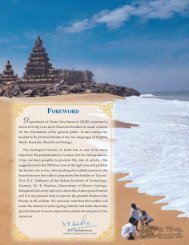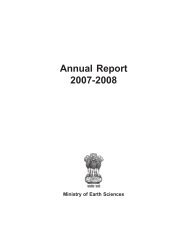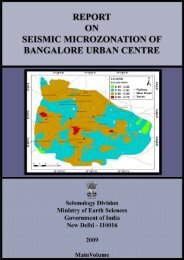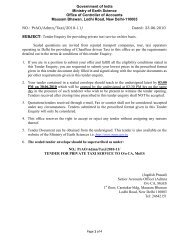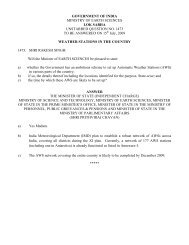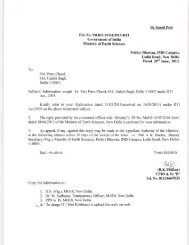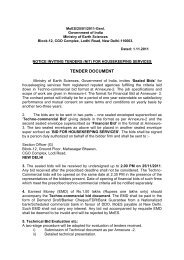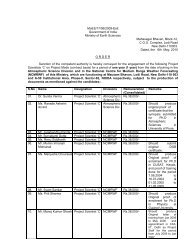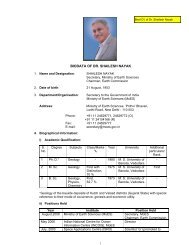Tsunami Report(Page 21-40)
Tsunami Report(Page 21-40)
Tsunami Report(Page 21-40)
Create successful ePaper yourself
Turn your PDF publications into a flip-book with our unique Google optimized e-Paper software.
4.1.1 Diving Indian plateThe earthquake of December 26 that occurred off the west coast of northernSumatra took place at the interface between the Indian and Burma plates, whereBurma plate has been referred by Andaman/Nicobar ridge that acts as a smalltectonic plate (Curray et al., 1982). In this region, the Burma plate is characterizedby significant strain partitioning due to oblique convergence of the India andAustralia plates to the west and the Sunda and Eurasian plates to the east. It is atypical oceanic-oceanic convergent plate boundary (Fig.11) where the Indian platemoving at a rate of 5 cm a year relative to the Burma plate came together, collidedand the Indian plate dived (subducted) under the Burma plate (Fig.12). Volcaniceruptions are commonly seen at such convergent boundaries. "Two major platetectonic features on either side of a narrow strip show how seismically active theregion is."(Source: USGS)FIG 11. A typical Oceanic-Oceanic convergent plate motion4.1.2 Lethal combinationA lethal combination of huge magnitude and shallow depth focus led to high verticaldisplacement of the Burma plate that acted like a great piston deforming the sea.The aftershocks within two hours at the Andaman islands following the mainearthquake in the Burma plate have gone further to fracture and move the Burmaplate boundary by 1000 km. That in essence is the power of the earthquake thatstruck off the Sumatra coast. The U.S.Geological Survey has called this event amega thrust earthquake referring to the large cracking of the plate boundary.<strong>21</strong>
According to them, mega thrust earthquakes often generate large tsunamis that cancause damage over a much wider area than is directly effected by ground shakingnear the earthquake's rupture. Aftershocks are distributed along much of the shallowplate boundary between northern Sumatra (approximately 3°N) to near AndamanIsland (at about 14°N).FIG 12. Base map of the Sumatra subduction zone showing seismicity associated withthe 2004 earthquake (Source: USGS).22
Shallow focus earthquakes measuring 6.5 can also cause tsunamis. But suchtsunamis will die out after some distance. The vast expanse of the Indian Oceanposed little challenge to the movement of the killer tsunami. Reaching a distance of2000 km to hit the Indian coast was not difficult. Perhaps giant tsunamis can travelas far as 5000 km. This was the first time that a tsunami of this magnitude hadstruck the Indian coast.Since a large amount of pent-up energy in the compression zones along the plateboundaries has been released in the recent earthquake of 26 th December 2004, it willtake years for another incident of the same magnitude to recur. But countries in theIndian Ocean should pay more attention to earthquakes and tsunamis in the future.5 Observations of December 26, 2004 <strong>Tsunami</strong> in India5.1 Simulation resultsA wave modelling generated by Active Fault Research Center, National Institute ofAdvanced Industrial Science and Technology, Japan highlights the crests and troughsof the tsunami waves as they travel across the Indian Ocean and refract aroundislands and interfere with each other (Fig. 13). A close observation of this modellingresults infer that the Andaman and Nicobar islands were hit by strongest tsunamiwaves in no time after it generated at north off Sumatra. The tsunami hit easternmost point of Sri Lankan coast after 100 minutes, coasts of Orissa and AndhraPradesh after 110 minutes and Tamilnadu coast after 120 minutes of its generation.It took more than 3 hrs to hit the western coast of India.The propagation of tsunami waves is much stronger in east-west direction thannorth-south direction as the approximate fault of 1200 km length and 100 km widthlies in near north-south orientation. As a result, strongest waves hit the coasts ofThailand, Indonesia and other nearby areas which are closely located on the east ofthe epicenter. The intensity of these tsunami waves that hit along the coastline ofOrissa and Andhra Pradesh is weak due to their diagonal propagation. However,southern east coast of India and Sri Lanka experienced much stronger tsunamiwaves due to their location in mere western side of epicenter. Though the Palk Strait23
and further southern areas of Tamilnadu are shadowed by Sri Lanka, the wavesrefract around island and inundated these coastal areas. The damage to Kerala coaston the west coast of India is also due to this wave refraction beyond Kanyakumari.The wave modelling by Institute of Geophysics and Planetary Physics, University ofCalifornia also revealed similar results (Fig.14). According to this simulation, tsunamiwave hit Chennai coast about 110 minutes after its generation and has got 1.4 m ofrun up.10 min50 min100 min110 min120 min180 minFIG 13. Visualisation of <strong>Tsunami</strong> Wave propagation across Indian Ocean.The red color indicates the water surface is higher than normal, while the blue indicateslower (Courtesy: National Institute of Advanced Industrial Science and Technology, Japan).24
<strong>Tsunami</strong> energyFIG 14. Simulation of <strong>Tsunami</strong> Wave propagation across Indian Ocean(Courtesy: Institute of Geophysics and Planetary Physics, University of California)5.2 Physical ObservationsNational Institute of Ocean Technology (NIOT), Chennai has deployed Acoustic TideGauges (ATG) at selected places along the Indian coast and Port Blair. The tidegauge at Port Blair, S.Andaman functioned normally till 06.50 hrs on 26 th December2004 and showed the tide level of 2.4 m. At 07:15 hrs tide gauge showed abnormallyhigh water level of 3.48 m, an increase of water level by 1.0 m due to tsunami (Fig.15). It is to note that the tide levels immediately after the tsunami are around 0.8 m,above the normal sea level. This may be due to the subsidence of the land in PortBlair. The tide levels recorded by Andaman harbour works in Port Blair at differentjetties also seem to be showing tide level in excess of 0.8 m which confirm possibleland subsidence to this extent.25
Tide in cms<strong>40</strong>0350300250200150100507:150<strong>21</strong>-12-04 23-12-04 25-12-04 27-12-04 29-12-04 31-12-04 3/1/2005 5/1/2005Time(Courtesy: NIOT, Chennai)FIG 15. Variation of Tide at Port Blair during <strong>Tsunami</strong>.NIOT’s ATG at Chennai has also recorded the first signal of tsunami in the form of“receding water” at 09:06 hrs at Chennai Port Trust followed by abnormality in tidelevel at 09:15 hrs on 26 th December 2004 (Fig.16). The tide gauge was overwhelmedby the sudden and abnormally high water level and harbour oscillations due to whichthe tide record showed a saturation at around 1.5 m. However, the lower rangesclearly show that the water level should have been much above 1.5 m. Thedifference between the time of occurrence of tsunami at Port Blair, Andaman andChennai is around 2 hrs and corresponds well with the distance between Chennaiand Port Blair and the speed of the tsunami wave.(Courtesy: NIOT, Chennai)FIG 16. Variation of Tide at Chennai Port Trust during <strong>Tsunami</strong>26
The Tide gauge data from major ports of India maintained by Survey of India hasbeen processed by National Institute of Oceanography which showed that thetsunami hit Chennai at 09:06 hrs, Machillipatanam, Visakhapatnam and Paradip, at09:05 hrs, Tuticorin at 09:57 hrs, along the east coast and on the west coast it hitKochi at 11:10 hrs and Mormugao at 12:25 hrs (Fig.17). The non-tidal oscillationscontinued at Visakhapatnam, Tuticorin, Kochi and Mormugao well after the mainevent took place. NIOT’s ATG at Kochi has also recorded first hit of tsunami at11:12 hrs coincided with that of Survey of India tide gauge.There were no reports of inundation of coastal areas due to tsunami in the northernAndhra Pradesh and Orissa as the water level rose by less than 0.5 m. However, theinland areas like Ports and Harbours, for example, Visakhapatnam Fishing Harbourand Port experienced amplification of tide due to coning effect from outer harbour toentrance channel and unusual current speed in the order of 5 to 10 m/s (Fig.18).These strong flood and ebb currents have forcefully pulled 15-20 fishing boats out ofharbour (Fig.19); during the course few boats encountered minor damage.Although Tuticorin is situated south of Rameswaram, Tamilnadu, it witnessedtsunami at 09:57 hrs, almost an hour later it hit Chennai coast. It is to notice thatwhen high energy tsunami waves traverse horizontally across Indian Ocean, the eastcoast of Sri Lanka has absorbed the devastating tsunami energy and the refractedwaves with low energy only reached its west coast and southern east coast ofTamilnadu, which is confirmed by the wave modelling studies (Figs. 13 & 14). Thusmost of the southern coastal belt of Tamilnadu, shadowed by Sri Lanka, were lessaffected. It is for this reason, the refracted tsunami waves took more time to reachTuticorin.27
FIG 17. Observed Tide at different Ports showing the sea level changes on December 26, 2004.Red arrow indicates the approximate time of occurrence of the earthquake off Sumatra andthe blue arrow indicates the time of arrival of the disturbance at respective places.(Courtesy: Survey of India and NIO).28
FIG 18. Variation of Wave height and Water level during <strong>Tsunami</strong> atVisakhapatnam Port (Courtesy: INDOMER, Chennai)(Source: ICMAM-PD, Chennai)FIG 19. Boats pulling out of Visakhapatnam Fishing Harbour (VSH) by strong<strong>Tsunami</strong> ebb currents. VSH is one of the Hot Spot location of DOD’s COMAPS programmeand the strong currents churned the bottom sediments resulting black, muddy polluted ebbwaters (in yellow circles).29
5.3 Extent of Inundation along Tamilnadu and Andaman & NicobarIslands - observations by ICMAM-PD, DOD, ChennaiThe coast of Tamilnadu experienced different levels of impact with northern andsouthern coastal belt showed less human loss of about 8000 people.5.3.1 Chennai coastA team of scientists from ICMAM-PD visited Besant Nagar Beach in Chennaiimmediately after hearing the first hit of tsunami to Chennai at 09:00 hrs andmonitored the water level fluctuation from 10:00 hrs to 18:00 hrs on 26.12.2004using sophisticated Real Time Kinematic GPS (Leica SR530, having accuracy of 1 cmfor position and 15 cm for elevation) and DGPS (Leica GS5+) and analysed theimpact of tsunamis. Figure 20 shows the extent of seawater excretion over a periodof time.200 m150 mData: ICMAM-PDFIG 20. Variation of Water level at Besant Nagar beach, Chennai on 26.12.2004.At 09:00 hrs as the tsunami hit the Chennai coast, water excursed to a maximum of200 m inside the beach (up to kerb wall of the beach) with a surge height of 2.5 m.30
Subsequently a series of waves hit the coast at 10:45 hrs, 12:30 hrs, 15:10 hrs and17:10 hrs and the sea level returned to the original level around 18:30 hrs. At14:50 hrs water line receded by 150 m from the original shore (Fig.<strong>21</strong>). Theobservations revealed that the run-up height at Chennai is about 3 m. Thiscontradicts the estimated run-up height of 1.4 m at Chennai by Institute ofGeophysics and Planetary Physics, University of California (Fig.14) indicating thattheir model needs further calibration with regional data.HWLMWLLWLICMAM-PDFIG <strong>21</strong>. Visuals of water level change during <strong>Tsunami</strong> at Besant Nagar beach,ChennaiScientists of ICMAM-PD making observations using RTK and DGPS.Elevation of beach/land and presence of sand dunes are controlling factors for waterexcretion and extent of damage caused by the waves. Marina beach, a fewcentimeter above mean sea level, experienced maximum inundation. About 1.8 km 2of coastal area between Adyar and Cooum rivers along Chennai coast is inundated.The sea water excursed up to 590 m at Foreshore estate (Adyar river side) and480 m at MGR memorial (Cooum river side) with a narrow excursion of 290 m atmid-stretch (Fig.22). The series of tsunami waves had a positive effect on Adyar andCooum rivers, which are sewage carriers, whose mouths closed for most part of theyear due to sand accretion, got opened, though temporarily, due to which theseheavily polluted waters with sludge were flushed out to a great extent (Fig.23) which31
might be having significant impact (but temporarily) on the water quality and biotaof adjoining coastal environment. This can be clearly seen by the occurrence ofbacteria up to or beyond 10 km offshore after tsunami when they were sighted at amaximum distance of 3 km offshore before tsunami at selected locations (Table 3).AREA INUNDATEDBETWEEN ADAYARAND COOVUMRIVER IS ABOUT1.8 km 2 FIG 22. Extent of inundation at Chennai coast during <strong>Tsunami</strong>(Source: CAS in Marine Biology, Parangipettai)FIG 23. A view of polluted waters of Cooum river flushed out due to opening ofmouth as a result of <strong>Tsunami</strong>32
TABLE 3. Distribution of Bacterial population before and after <strong>Tsunami</strong>along Tamilnadu coastal watersBefore <strong>Tsunami</strong>After <strong>Tsunami</strong>Bacteria Stations Distance Stations Distance(km)*(km)*THB (Max) All stations 0.5, 1 & 3 Pondy 10E.Coli &FaecalcoliformSalmonella LO(Max)All stationsHot Spots &0.5Ennore 10Tuticorin & 0.5, 1 & 3 Nagapattinam 10ChennaiSFLO (min) Ennore coast 0.5 & 1 Ennore 3 & 5Water/SedimentAll stationsWater low/Sediment highWater &sediment slightvariation* distance from the coast. (Source: CAS in Marine Biology, Parangipettai)5.3.2 North Chennai between Ennore and PulicatObservations made along the north Chennai coast (Fig.24) indicated that the waterlevel at Ennore creek rose by a maximum of 5 m and water excursed up to 300 m atthe adjoining coast. Though the Katupallikuppam fishermen settlement, located 6 kmnorth of Ennore Port and 190 m away from the coast has escaped without anydamage due to their occupation on a sand dune, the sea water inundated to about500 m in low lying areas around the village. Further north, the Kalanji fishinghamlets were not affected by waves as the inundation is seen only up to 45 m.<strong>Tsunami</strong> in one way benefited the Pulicat Lake by wide opening its mouth, but itsfishing community, except a beach hamlet, is least affected due to presence of sanddunes. The above observations indicated that the extent of inundation decreasedfrom Ennore to Kalanji due to the presence of shoals at north of Ennore Port, whichacted as “wave dampers” in reduction of wave energy (Fig.24). Though this coastalbelt is prone to accretion/erosion due to construction of Ennore Port, the ongoingstudies of ICMAM-PD revealed that these shoals are acting as a natural barrier to thewave energy thereby controlling the intensity of erosion at north of Ennore Port.They also predicted that by considering the dimensions of these shoals, they maylast for another few years. If the damage occurred to these shoals due to tsunami issignificant, it will have considerable impact on the extent of their natural protection33
to this coast. In view of this, ICMAM-PD will soon undertake the monitoring of theseshoals to ascertain the extent of damage to them due to tsunami.HWLsand dune protectedinundationPulicatMinimum inundation due topresence of ennore shoals45 mKalanjiEnnore CreekFIG 24. Inundation of seawateralong north Chennai coast. Thisregion is less affected due topresence of shoals.(Data: ICMAM-PD)300 mMax water level during <strong>Tsunami</strong>2 m3 m34
5.3.3 South of ChennaiFIG 24.The preliminary results indicated that the southern Chennai upto Mahabalipuramalong east coast road has not been affected much due to steep land elevations andthe maximum inundation is seen up to 250 m. Presence of sand dunes andplantations at most of the locations played a vital role in protection of coastal villagesin this area. However in the Kalpakkam area where the Nuclear Power Plant issituated, the terrain is nearly flat and slightly elevated above mean sea level, greaterinundation is seen in this zone. The experience of coastal inundation between Pulicatand Kalpakkam due to this tsunami is that if CRZ is strictly implemented in this belt,there would not have been much loss to property and lives.A death toll of about 500 is reported from the coastal area of Cuddalore with aninundation of 1.5-2.0 kms at Devanampattinam coast mainly due to successive wavepropagations through the back waters. Severe damage is also noticed to fishingboats of this area. Further south of Cuddalore, the areas adjoined to the rivermouths of Vellar, Chinna Vaikal (Pichavaram) and Coleroon were severely damagedclaiming more than 1000 lives. The Parangipettai village (adjacent to Vellar river)witnessed maximum inundation up to 2.5 kms as the initial terrain slope (from coast)is very gentle and far reaching areas are low lying. The areas adjoined to Vellar inletand its back waters which were marked as a green region with dense plantationacted as a barricade to tsunami waves which resulted in reduction of wave energy,otherwise the intensity of the damage could have been much more severe. Thesatellite images before and after tsunami of this region clearly explain this bioshieldingeffect wherein the loss of vegetation after tsunami can be noticed (Fig.25).The Vellar inlet which is having two openings each of about 290 and 235 m width asobserved by a team of scientists from ICMAM-PD and IIT, Chennai on 24.12.04, aday before tsunami occurred was made opened to a great extent by tsunami wavesresulting the seawater ingression up to 5 km inside. The satellite imageries of thesemouth inlets before and after tsunami are presented in Figure 26. The flow of tidalwaters inside the estuary has inundated the paddy fields with seawater.35
06.08.200130.12.2004FIG 25. Loss of vegetation in and around Vellar inlet (in yellow circles) showingthe bio-shielding effect to <strong>Tsunami</strong> waves.36
(Courtesy: NRSA)FIG 26. Satellite imageries before and after <strong>Tsunami</strong> showing the extent ofopening to various inlets of Pichavaram area. (Source: NRSA)5.3.4 At NagapattinamNagapattinam, a coastal town, located about <strong>40</strong>0 km south of Chennai is the worstaffected place in India due to tsunami claiming more than 6000 death toll andextensive damage to the public and private property. It is believed that the dualwave effect (straight waves plus diffracted waves from Sri Lankan coast), gentleslope of continental shelf and gentle elevation of hinterland coupled with thepresence of Uppanar river and Vedaraniyam canal in the southern side triggered thedeadliest impact of tsunami waves. The preliminary observations revealed that theimpact on the southern part is deadliest than northern part due to the presence ofthese water bodies through which the successive progression of tsunami wavespushed the waters to distances beyond 2 km towards landside (Fig.27). However,the runup level in the northern part of Nagapattinam near Light House is close to 4m with a maximum inundation up to 755 m from the coast (Fig.28). Despitepresence of wide beach (~200 m), the gentle land topography facilitated landwardintrusion of seawater up to 800 m. Because of this, the high energetic waves crossedthe beach and flooded the human settlement. Severe damage has been noticed to<strong>21</strong>
hundreds of fishing boats, several acres of agricultural land and also to beachtourism (Fig.29).2.2 km(Image courtesy: Space imaging)FIG 27. Extent of inundation of seawater in Nagapattinam due to <strong>Tsunami</strong>.FIG 28. Extent of inundation in north Nagapattinam due to <strong>Tsunami</strong>(Image courtesy: Space imaging; Data source: ICMAM-PD, Chennai)22
Fishing HarbourAgricultural LandsBeach TourismFIG 29. Glimpse of damage occurred in Nagapattinam.5.3.5. <strong>Tsunami</strong> in Andaman and Nicobar islands and observations on runup levelsThe Andaman and Nicobar islands located in the subduction zone of Burma Plate isclassified as Seismic zone 5 indicating high level of risks due to earthquake (Fig. 30).<strong>Tsunami</strong> waves hit the Nicobar group of islands within few minutes andreached Port Blair in South Andaman at 07:15 hrs (Fig.15), immediately after itsgeneration at 06:45 hrs at Sumatra, indicating the traveling speed of about700 km/hr. The waves transformation varied at different locations (depending on thecoastal geomorphology) and the tips of islands faced more fury of tsunami waves.The Nicobar group of islands namely Great Nicobar, Katchall, Teressa, Nancowry,Trinkat, Car Nicobar etc. were severely affected by tsunami waves as they are closerto the epicenter and also smaller in nature surrounded by the sea all around. Theimpact on Andaman group of islands were less except on Little Andamans due totheir geometry and nature of topography (Fig.30). Since the settlement in SouthAndaman islands is largely confined in sheltered areas like bays and they are farfrom the coast and more importantly the settlement areas are in elevated areasexcept in certain low elevated far inland locations like Sippighat area, there werealmost no loss of life, but damage to properties especially to fishing vessels were23
considerable. The extent of loss of life in A & N islands due to tsunami is given inTable 4.Table 4. Death toll in A & N islands as of 23.1.05 due to <strong>Tsunami</strong>S.NoIslandsPopulationon (2001census)DeadMissingPersonsincamp*NICOBAR DISTRICT1. Car Nicobar 20292 790 348 155502. Teressa 2026 50 9 32963. Katchal 5312 345 4310 18184. Nancowry 927 1 2 9345. Camorta 3412 51 387 14766. Great Nicobar 7566 336 <strong>21</strong>9 46907.Other Islands ofNicobar (evacuated)2533 288 266 --Sub-total 42068 1861 5541 27764ANDAMAN DISTRICT1.Andaman includes,Port Blair181949 5 -- 28332. Little Andaman 17528 56 14 65693.Other Islands ofAndaman114607 3 -- 5000Sub total 31<strong>40</strong>84 64 14 14<strong>40</strong>2Total (UT) 356152 1925 5555 4<strong>21</strong>66* includes persons from other affected islands. (Source: A & N Administration)The inundation of seawater into the land with high velocity and their retreatwith same or higher velocity cause extensive damage to human life and property. Assaid extent of inundation is measured in term of vertical run-up (Fig.4). The extent ofvertical run-up of seawater depends on nearshore bathymetry, beach profile, landtopography and velocity of tsunami waves and their frequency. Due to theseparametric variations in Andaman and Nicobar islands, the run-up level and landwardpenetration characteristics of seawater varied from one location to the other within anisland. The geometry of the islands and existence of offshore barriers like islets,trenches also play a role in the landward propagation of tsunami waves. Keepingthese issues in mind and in order to get an idea on run-up levels, they weremeasured at a few selected locations which are considered to be representative.24




